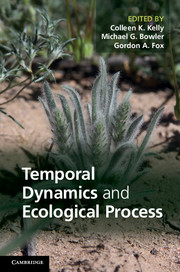Book contents
- Frontmatter
- Contents
- List of Contributors
- 1 Introduction
- Part I Observing temporal processes in nature
- 2 The storage effect: definition and tests in two plant communities
- 3 What temporal processes in trees tell us about competition, community structure and speciation
- 4 Testing the storage effect with long-term observational data
- 5 Seedling herbivory and the temporal niche
- 6 Temporal variation in density dependence in an herbaceous community
- 7 Population and community dynamics in variable environments: the desert annual system
- 8 Temporal niches, ecosystem function and climate change
- Part II Application to specific questions
- Index
- References
6 - Temporal variation in density dependence in an herbaceous community
Published online by Cambridge University Press: 18 December 2013
- Frontmatter
- Contents
- List of Contributors
- 1 Introduction
- Part I Observing temporal processes in nature
- 2 The storage effect: definition and tests in two plant communities
- 3 What temporal processes in trees tell us about competition, community structure and speciation
- 4 Testing the storage effect with long-term observational data
- 5 Seedling herbivory and the temporal niche
- 6 Temporal variation in density dependence in an herbaceous community
- 7 Population and community dynamics in variable environments: the desert annual system
- 8 Temporal niches, ecosystem function and climate change
- Part II Application to specific questions
- Index
- References
Summary
Introduction
Plant communities are structured in time as well as space. Their component species may differ in the timing of establishment, growth and reproduction both within and between years, creating temporal differences in relative abundances. Under appropriate conditions, temporal differences among co-occurring species can allow their coexistence (Grubb 1977, Chesson and Huntly 1997, Higgins et al. 2000, Kelly and Bowler 2002, 2005, Chesson et al. 2004, Schwinning et al. 2004, Adler et al. 2006). Whether or not temporal differences are responsible for the coexistence of any given pair or set of species, temporal niches are a fundamental part of community structure. Understanding this aspect of community structure is becoming even more important as we are called upon to interpret and to predict responses of communities to climate change (Dukes and Mooney 1999, Walther et al. 2002, Fischlin et al. 2007).
In this study we examine temporal variation in population dynamics in a set of eight co-occurring herbaceous perennials. In addition to examining temporal variation in population sizes (densities), we use simple population dynamic models to provide estimates of temporal variation in equilibrium population density. Because actual densities lagged equilibrium population densities, the latter were more useful for comparing the temporal niches of different species and for relating temporal variation in precipitation to population dynamics. The degree of lag itself can be interpreted as a measure of the intensity of density-dependent population regulation, and variation in the degree of lag as another aspect of a species’ temporal niche.
- Type
- Chapter
- Information
- Temporal Dynamics and Ecological Process , pp. 123 - 139Publisher: Cambridge University PressPrint publication year: 2014



